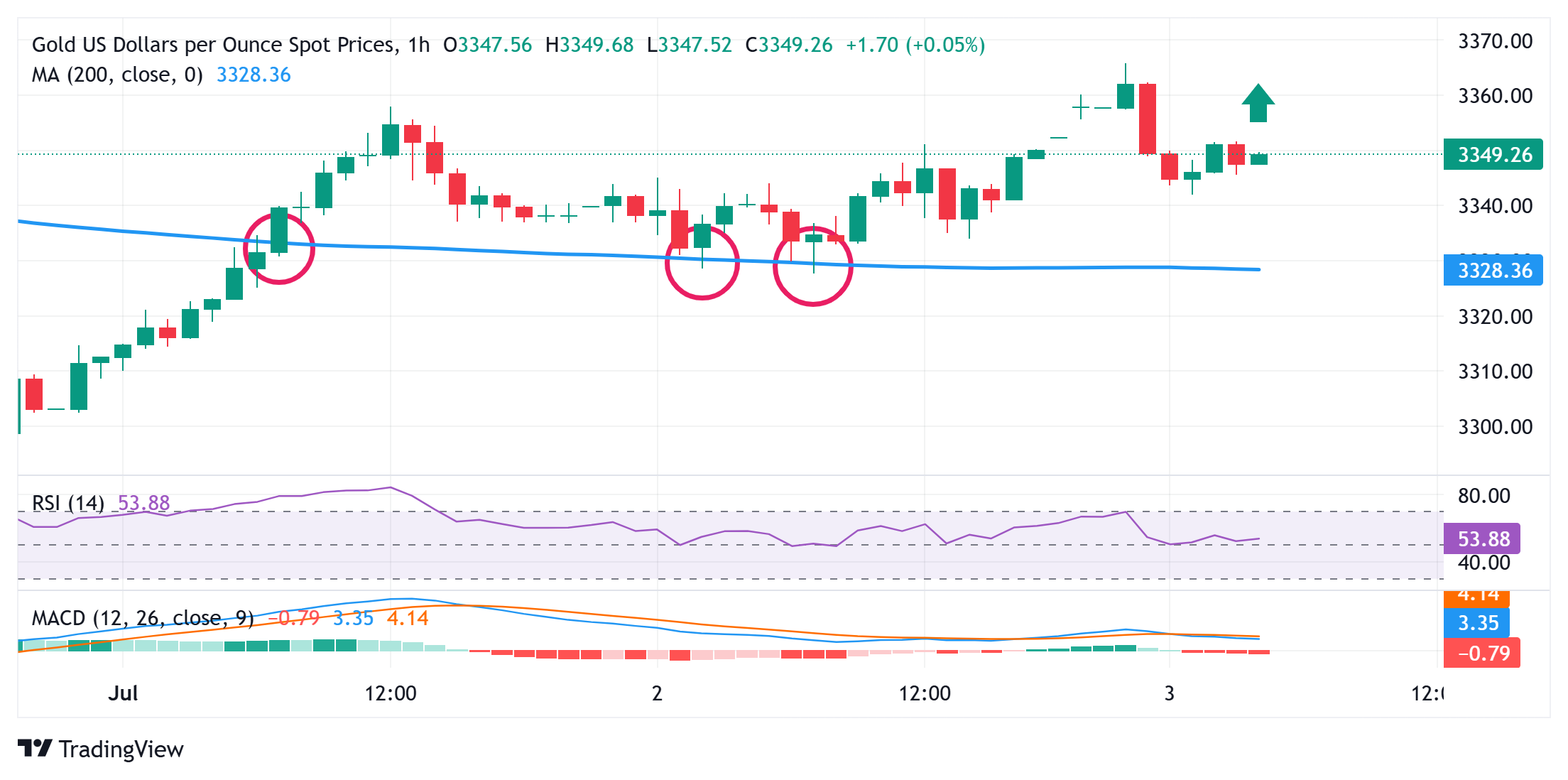- Gold price reverses a modest Asian session dip, though it lacks follow-through.
- A US-Vietnam trade deal undermines demand for the safe-haven precious metal.
- Fed rate cut bets cap the USD and support the commodity ahead of the US NFP.
Gold price (XAU/USD) attracts some dip-buyers heading into the European session and climbs to the top end of its daily range, back closer to the over one-week high touched earlier this Thursday. The US Dollar (USD) continues with its struggle to attract any meaningful buyers and hangs near a multi-year low amid the growing acceptance that the Federal Reserve (Fed) will resume its rate-cutting cycle in the near future. This turns out to be a key factor acting as a tailwind for the non-yielding yellow metal.
A trade agreement between the US and Vietnam eased market concerns over prolonged trade tensions, which boosts investors’ confidence and remains supportive of a positive risk tone. This, in turn, could act as a headwind for the safe-haven Gold price and cap any further gains. Traders might also refrain from placing aggressive bets and opt to wait for the US Nonfarm Payrolls (NFP) report for cues about the Fed’s rate-cut path, which will drive the USD and provide a fresh impetus to the XAU/USD pair.
Daily Digest Market Movers: Gold price bulls not ready to give up amid dovish Fed expectations
- President Donald Trump announced on Wednesday that the United States has struck a trade agreement with Vietnam. The US will impose a lower, 20% tariff on goods imported from the Southeast Asian nation, and the deal will give the US tariff-free access to Vietnam’s markets.
- Meanwhile, negotiators from the US and India are pushing to land a tariff-reducing deal ahead of Trump’s July 9 deadline. The developments boost investors’ confidence and prompt some profit-taking around the safe-haven Gold price following a three-day winning streak.
- However, Trump has indicated no signs of extending the negotiation deadline despite stalled discussions with Japan, another key trade partner. This keeps trade-related uncertainties in play, which, in turn, might continue to offer some support to the precious metal.
- On the economic data front, the Automatic Data Processing (ADP) reported that US private payrolls fell for the first time in more than two years during June. In fact, the US private-sector employment unexpectedly declined by 33K compared to the downwardly revised rise of 29K.
- This comes on top of Tuesday’s Job Openings and Labor Turnover Survey, or JOLTS report, and underscores a deteriorating trend in the US labor market. Moreover, a sluggish hiring environment might force the Federal Reserve (Fed) to start cutting interest rates again as early as this month.
- In fact, traders are currently pricing in nearly a 25% chance of a rate cut by the Fed at the July 29-30 monetary policy meeting. Moreover, a 25 basis point rate cut in September is all but certain, and expectations for two rate reductions by the end of this year are also high.
- Dovish Fed expectations should keep a lid on the US Dollar’s attempted recovery from a three-and-a-half-year low and contribute to limiting losses for the non-yielding yellow metal. Traders might also opt to wait for the release of the US Nonfarm Payrolls (NFP) report.
Gold price seems poised to appreciate further; bulls might aim to reclaim the $3,400 mark

From a technical perspective, this week’s breakout above the 200-hour Simple Moving Average (SMA) was seen as a key trigger for the XAU/USD bulls. Moreover, oscillators on the daily chart have again started gaining positive traction and suggest that the path of least resistance for the Gold price is to the upside. Hence, any subsequent slide might still be seen as a buying opportunity and remain cushioned near the $3,330-3,329 region (200-hour SMA). A convincing break below, however, might prompt some technical selling and drag the commodity further towards the $3,300 round figure.
On the flip side, the $3,363-$3,365 zone, or over a one-week high touched on Wednesday, now seems to act as an immediate hurdle, above which the Gold price could aim to reclaim the $3,400 mark. A sustained strength beyond the latter would negate any near-term negative outlook and lift the XAU/USD pair to the next relevant hurdle near the $3,435-$3,440 region.
Fed FAQs
Monetary policy in the US is shaped by the Federal Reserve (Fed). The Fed has two mandates: to achieve price stability and foster full employment. Its primary tool to achieve these goals is by adjusting interest rates.
When prices are rising too quickly and inflation is above the Fed’s 2% target, it raises interest rates, increasing borrowing costs throughout the economy. This results in a stronger US Dollar (USD) as it makes the US a more attractive place for international investors to park their money.
When inflation falls below 2% or the Unemployment Rate is too high, the Fed may lower interest rates to encourage borrowing, which weighs on the Greenback.
The Federal Reserve (Fed) holds eight policy meetings a year, where the Federal Open Market Committee (FOMC) assesses economic conditions and makes monetary policy decisions.
The FOMC is attended by twelve Fed officials – the seven members of the Board of Governors, the president of the Federal Reserve Bank of New York, and four of the remaining eleven regional Reserve Bank presidents, who serve one-year terms on a rotating basis.
In extreme situations, the Federal Reserve may resort to a policy named Quantitative Easing (QE). QE is the process by which the Fed substantially increases the flow of credit in a stuck financial system.
It is a non-standard policy measure used during crises or when inflation is extremely low. It was the Fed’s weapon of choice during the Great Financial Crisis in 2008. It involves the Fed printing more Dollars and using them to buy high grade bonds from financial institutions. QE usually weakens the US Dollar.
Quantitative tightening (QT) is the reverse process of QE, whereby the Federal Reserve stops buying bonds from financial institutions and does not reinvest the principal from the bonds it holds maturing, to purchase new bonds. It is usually positive for the value of the US Dollar.

